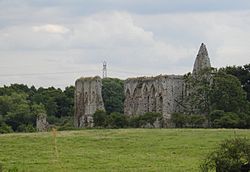Newark Priory facts for kids

The remains of Newark Priory
|
|
| Monastery information | |
|---|---|
| Order | Augustinian |
| Established | between 1189-1199 |
| Disestablished | 1538 |
| Dedicated to | Virgin Mary and Thomas Becket |
| Diocese | Diocese of Guildford |
| Controlled churches | Old Woking, with its chapels of Horsell and Pyrford; Send; St. Martha, St Marth's Hill, Guildford; Wanborough; Weybridge; Windlesham with its chapel; Leigh all in Surrey; and Shipton with its (suspected near Snoddington Manor) chapel of Snodington, Hampshire. |
| People | |
| Founder(s) | Rauld de Calva and his wife Beatrice de Saudes |
| Important associated figures | Richard Lipscombe, Lord Onslow |
| Site | |
| Location | Pyrford, Surrey, England |
| Coordinates | 51°18′32″N 0°30′24″W / 51.3089°N 0.5068°W |
| Visible remains | Yes |
| Public access | No |
| Official name | Newark Priory: an Augustinian priory north of the River Wey |
| Designated | 20 November 1925 |
| Reference no. | 1008303 |
|
Listed Building – Grade I
|
|
| Official name | Ruins of Newark Priory |
| Designated | 14 June 1967 |
| Reference no. | 1377835 |
Newark Priory is an old, ruined priory in Surrey, England. It sits on an island, surrounded by the River Wey and a small stream called the Abbey Stream. You can find it near the villages of Ripley and Pyrford.
Contents
History of Newark Priory
Early Days of the Priory
Newark Priory was once home to a group of religious people called Augustinian canons. These canons were like priests who lived together in a community. Records from 1312 show that a Bishop of Winchester first started the priory.
The priory got a lot of land in the late 1100s. A couple named Rauld de Calva and Beatrice de Sandes gave the land. They wanted the Augustinian canons to build a church there. This happened when King Richard I was ruling, between 1189 and 1199. The priory's style, called Early English Gothic, matches this time period.
The priory was dedicated to the Virgin Mary and Saint Thomas Becket. At first, the land was called Aldbury. But over time, its name changed to Newark, which means "New Place." It was also sometimes called Newstead.
Life at the Priory
In 1291, a special record called a taxation roll showed that the priory owned many things outside of its religious duties. This included buildings or rents in ten different areas of London. They also earned money from lands in other parts of England.
The Priory's End
Newark Priory was closed down during the time of King Henry VIII. This period was known as the Dissolution of the Monasteries. The person in charge of the priory, called the prior, was given a pension. All the valuable items from the priory were sent to the Tower of London. The land itself was given to the Master of the King's Horse.
There's a story that a cannon was used to destroy the priory. It was supposedly fired from Church Hill to knock down the large buildings. An artist named Tessa Kewen even painted this scene. The last prior of Newark Priory was Richard Lipscombe. He was appointed just before the priory and its lands were given up in 1538.
After it was closed, the building started to fall apart. Locals even used stones from the ruins to fix roads. But in the 1730s, the owner, Lord Onslow, decided to protect what was left.
Newark Priory Today
Visiting the Ruins
Today, Newark Priory is still a set of ruins. It is a very important historical site. It is listed as a scheduled monument and a Grade I listed building. This means it's a building of exceptional historical interest.
The ruins are on private land. This means you cannot get very close to them. However, you can see them from the path along the River Wey, near Newark Lock and Newark Mill. The island where the ruins stand is a meadow. Newark Lane, which runs between Pyrford and Ripley, crosses one end of it.
Easter Service
Every year on Easter Day, a special service is held at dawn in the ruins. This service starts at 6 AM. Churches from nearby towns like Byfleet, West Byfleet, Pyrford, and Ripley organize it.

